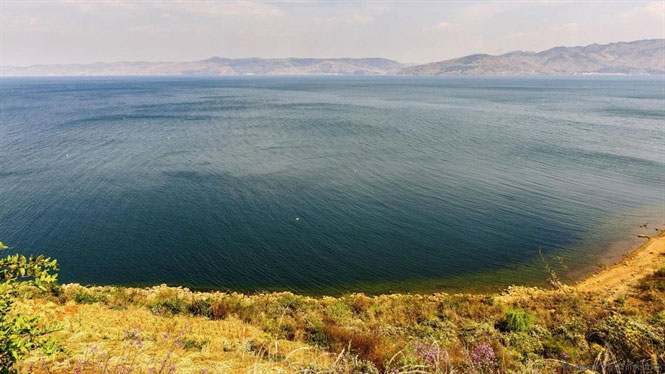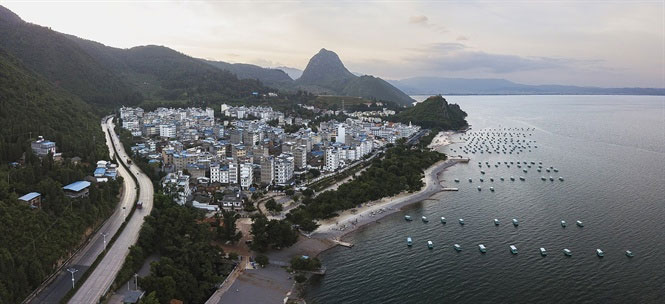The ancient 'city' mystery at the bottom of the lake no one knows for thousands of years
Phu Tien Lake is the third largest in Yunnan Province (China), behind Dien Tri Lake and Nhi Hai Lake. But in three lakes, it is the deepest lake, with places up to 155m.
Phu Tien Lake, 21 km 2 wide, hides an ancient 'city' , no one knows for thousands of years.

Phu Tien Lake.
China daily reported that one day in 2001, a professional diver named Jing Wei discovered something strange at the bottom of Phu Tien lake. What Scene found was some stone materials including paving stones, moss-covered rocks . Jing Wei believes that these stones are from a long time ago. However, why are they at the bottom of the lake? Where do they come from? The scene suddenly recalls a mysterious legend about Phu Tien Lake. Local people often say on beautiful days, standing on a nearby mountain can see the silhouette of a city at the bottom of the water.
Is this the ancient town spoken in legend? To decipher this question, Canh made 38 dive surveys. Finally, he wrote a report to the authorities and experts in Yunnan Province.
Find the mark of the ancients
To clarify the mystery, people sent to Phu Tien lake an archaeological team equipped with submarines. They discovered more square blocks scattered on the bottom of the lake. With the support of modern search devices, they saw, on the screen of the sensor, next to many paving stones were stone walls. There are also high stone steps. The moss-covered paving stones seem to have opened an ancient city for some reason, sunk to the bottom of the lake .

New urban area next to Phu Tien lake.
The archaeological team measured the extent of the ruins at the bottom of Phu Tien Lake and found that it was extremely large, the remains of buildings were everywhere. After many days of observation and analysis, archaeologists estimate that the area of the ruins is 2.4-2.7 km 2 . So where does this ruins come from?
Some experts believe that this may be the ruins of the ancient town of Du Vien, mysteriously disappeared centuries ago.
The Han Dynasty book (which records Chinese history from the period of Western Han 206 before CN to the 9th century AD) states that Yu Yuan was located north of Phu Tien Lake.
Is this the city recorded in the Han book? To answer this question, the researchers first had to determine the date of the ruins, which coincided with what history had recorded. They must find objects that interact with daily life, with human use. After a two-week survey, archaeologists found some earthenware.
Experts believe that, from these terracotta utensils, this ruins can be concluded from the Eastern Han Dynasty . However, to determine a more accurate date, they have to find objects that can apply carbon testing technology.
A city of the Han Dynasty
After many failed attempts, archaeologists finally identified the object found in the ruins of the 1750-year-old. This proves that the ancient city was sunk during the Han Dynasty. However, by the Tang Dynasty, history books still recognize the existence of the ancient Vien Vien citadel. Therefore, the ruins area is not the ancient town of Du Vien.

Stone works on the bottom of the lake.
Some experts believe that the structure of the ancient urban bottom of the lake is extremely similar to the architecture of Dien Quoc, which has a highly developed civilization. After 86 BC, Dien Quoc mysteriously disappeared.
However, many scientists are still skeptical, because archeology is a long and complex process. Addressing questions about the ruins need time and elaborate research.
In 2014, an archaeological team continued to find archaeological evidence of urban bottom of the lake. A search was carried out on the east side of the 20-day Phu Tien Lake, allowing scientists to map parts of the ruins, take photos and, perhaps most importantly, find more dozens. Ruins of ruins sink in oblivion for thousands of years.
Scientists from the Chinese Society for Cultural Research and Yunnan University conducted fieldwork, collecting 442 stone artifacts.
The number of these objects is analyzed more thoroughly when taken to the laboratory. While conducting scout surveys, scientists have captured many stone engravings, recorded many places and ruins. The archaeological team said on the stone inscriptions there are characters and drawings similar to those in the I Ching, there are external genital drawings of men and women, pictures depicting the moon and the sun. 30 buildings, walls, and paved roads were counted.

A stone path.
Archaeologist Professor Hoang Y Luc of Van Nam University told reporters: 'Our survey targets the survey results organized by Central Television Television in 2001 and 2006. ' . These surveys all use diving equipment, actually creating more speculation than providing solid academic evidence. At that time, CCTV often called the ruins at Phu Tien Lake as 'Pompeii China' or 'Atlantis China'.
However, up to now, the most certain thing about the ruins of Phu Tien lake is that it was born at the same time and has some connection with the country . According to Professor Hoang, there is no historical record in Chinese history books about an advanced stone civilization dating back to the identified carbon analysis. Although Phu Tien Lake is the second deepest lake in China, the recent dive surveys only reach a depth of 7m, so there are many things waiting for scientists to discover.
- City of thousand years old at the bottom of the lake
- The intact ancient city of the lake is incredibly beautiful
- 5 ancient cities were discovered after thousands of years missing
- Unexpected discovery of ancient ships disappeared for over 300 years
- Dive to the bottom of the coldest lake in the winter
- 10 legendary ancient legends to this day
- The 7,000-year-old graveyard was buried at the bottom of the sea
- 'Lake of the devil': Detects tremors at a depth of 4000m
- Decode mystery aircraft under the lake
- Ancient cities thought only in legend
- 41 minutes on the bottom of the lake and the marvelous end of the 13-year-old boy shocked the doctor
- Discover the origin of the ancient lake under the desert
 Discovered an ancient centipede fossil 99 million years old
Discovered an ancient centipede fossil 99 million years old Discovered bat-like dinosaurs in China
Discovered bat-like dinosaurs in China Discovered a 200-year-old bronze cannon of the coast
Discovered a 200-year-old bronze cannon of the coast Discover 305 million-year-old spider fossils
Discover 305 million-year-old spider fossils Discover the mystery behind the world's roundest natural lake
Discover the mystery behind the world's roundest natural lake  Mysterious wonders of the world
Mysterious wonders of the world  The strange life of the 'black blood' tribe living on the world's highest freshwater lake
The strange life of the 'black blood' tribe living on the world's highest freshwater lake  The Mystery and Engineering Feat of Albano Emissary: The 2,000-Year-Old Roman Tunnel
The Mystery and Engineering Feat of Albano Emissary: The 2,000-Year-Old Roman Tunnel  Hundreds of fish jumped out of the lake in China, what happened?
Hundreds of fish jumped out of the lake in China, what happened?  Mysterious blue rock gives scientists a headache
Mysterious blue rock gives scientists a headache 